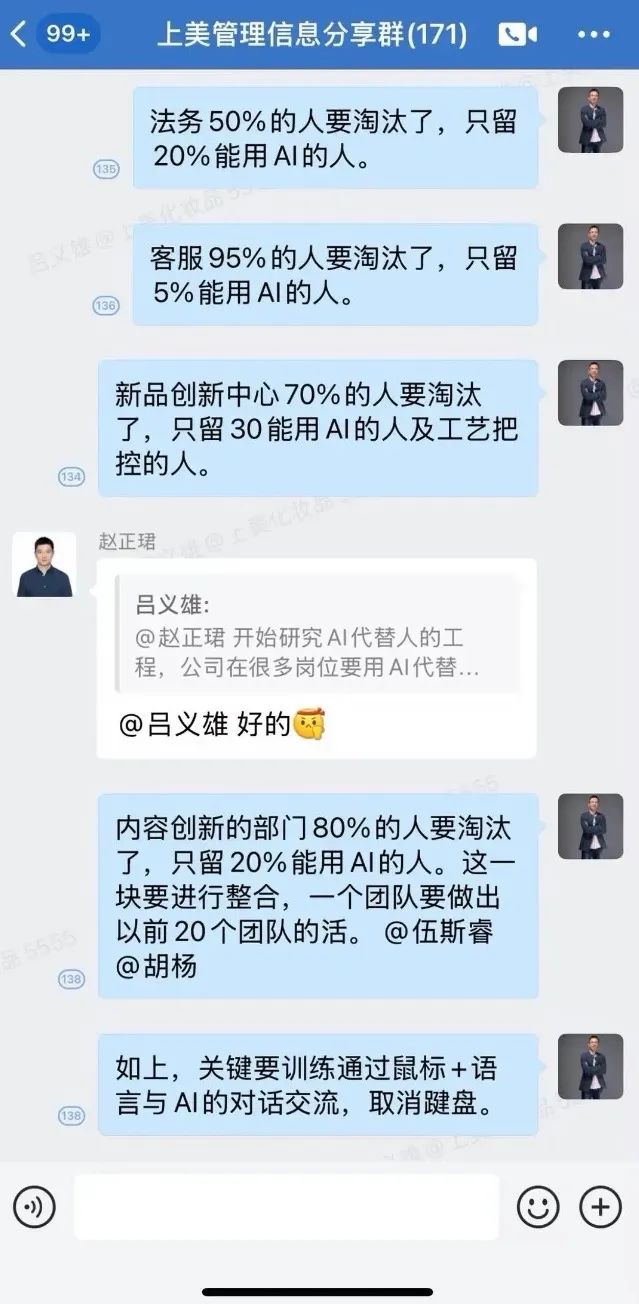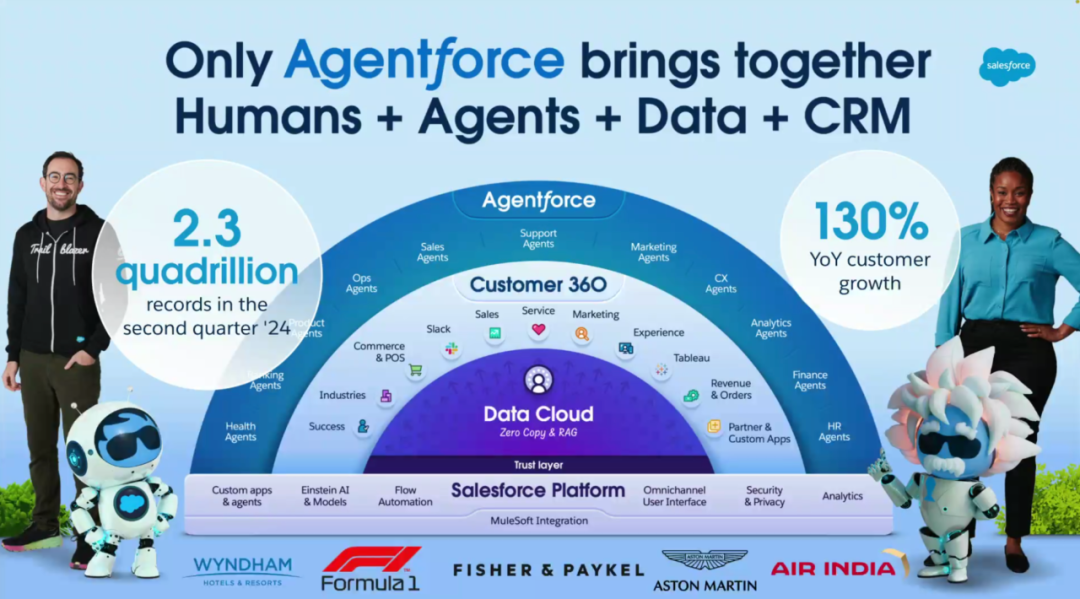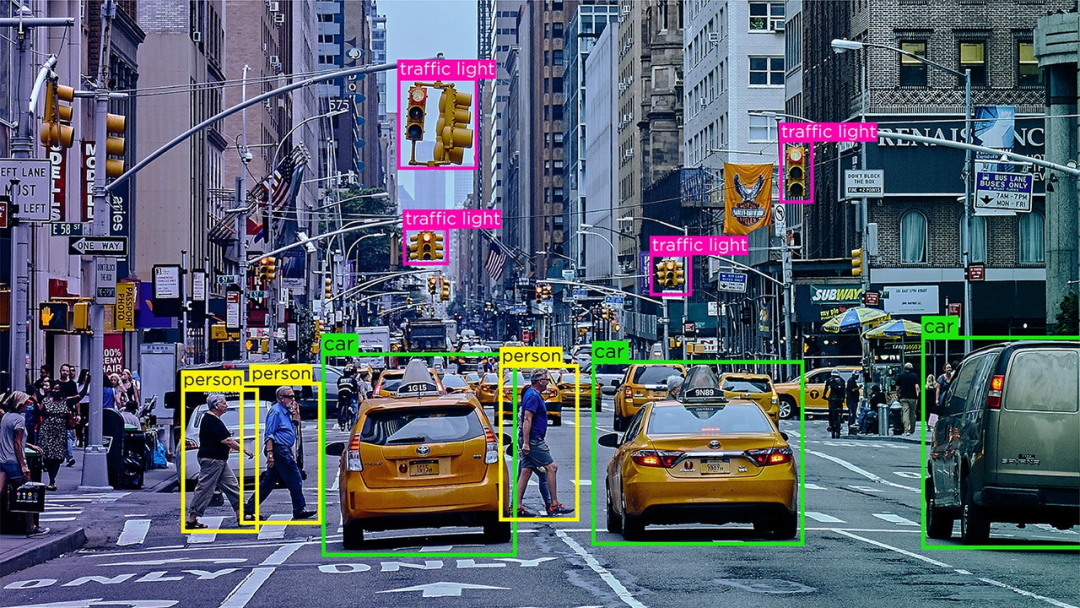Article source: Boundaries Unknown

In the past two days, screenshots of a chat in a work group of Lu Yixiong, founder of Hanshu’s parent company, Shangmei, have gone viral on social media.
In the chat screenshot, Lu Yixiong expressed a radical employment strategy,That is to replace most people with AI, leaving only a small number of people who can use AI.
For example, 50% of the people in the legal department should be eliminated, leaving only 20% of those who can use AI; 95% of the people in the customer service department should be eliminated, leaving only 5% of those who can use AI; 70% of the people in the new product innovation center should be eliminated, leaving only 30% of people who can use AI…

▲ Screenshots circulated on the Internet about Shangmei Shares Lu Yixiong
Later, although Lu Yixiong published an article in his circle of friends explaining that the company was not laying off employees and that the total number of people in the United States would increase by 800 this year, he did not deny the authenticity of the screenshots.
In fact, there was extensive discussion on domestic social media about the fact that AI would bring large-scale layoffs as early as 2023, when the big model was just released.At that time, almost all entrepreneurs were asked the same question-how to view the replacement of people brought by AI.
Similarly, almost everyone who is asked this question will give the same answer:Throughout history, technological change will inevitably lead to the disappearance of some jobs, but it will definitely create more new jobs in the end.
Then most of the discussion on the issue ended there, and everyone seemed to accept the explanation.
But over the past year or so, as AI has entered our work and lives more widely, and more and more people have actually used AI, we have discovered that this problem is not as simple as originally thought.
What AI faces is not just the problem of personnel replacement. It is more related to the trade-offs of a civilized society in the process of progress of the times. It is related to how we should take care of the “weak” of society and bring dignity and dignity to the entire society.
AI substitution is unstoppable!
The screenshots of Shangmei are popular, but the things facing Shangmei are obviously not unique.
For example, deepseek has been very popular recently. After seeing the test results generated by programs internally connected to deepseek, a listed company owner I know said on the spot that programmers below the industry average could be eliminated in the future.
And such a judgment is by no means alarmist. In fact, in European and American countries, there are countless news of layoffs caused by AI.
For example, in a blog post in December 2024, Marc Benioff, founder and CEO of Salesforce, mentioned when talking about the company’s plans for 2025:“Due to significant improvements in artificial intelligence productivity, Salesforce will no longer hire any software engineers in 2025.”
In September 2024, Salesforce launched an artificial intelligence platform called Agentforce, on which companies can create their own Agents. These Agents can be applied in hotels, hospitals and other scenarios and work 24 hours a day. Of course, they can also collaborate with humans.

▲ Picture: Salesforce’s introduction to Agentforce
Salesforce defines Agentforce as a digital workforce platform, and Salesforce has taken the lead in applying it. Benioff saidIn 2024, Salesforce leveraged Agentforce and other AI technologies for engineering teams to increase productivity by more than 30%.
Benioff believes,”This is the beginning of humans and agents working together. The way humans work will change and the commercial economy will be reshaped.”
Sam Altman, founder and CEO of OpenAI, has the same idea. He wrote in his year-end summary for 2024:“We believe 2025 will see the first artificial intelligence agents join the workforce and fundamentally change the company’s output.”
As if to prove their judgment, on January 23, Benioff announced Agentforce’s latest results. In Salesforce’s fiscal fourth quarter ending in January, thousands of transactions will be recorded on its Agentforce AI products.
Salesforce is of course just a typical representative of this huge AI replacement. The larger-scale replacement of personnel has actually begun earlier, and customer service is the first profession.
Stockholm-based Klarna is currently the world’s largest installment shopping company, and Klarna is also a staunch advocate and practitioner of AI.
As early as 2023, Klarna started working with OpenAI to create intelligent customer service based on ChatGPT. According to data disclosed by Klarna in early 2024, two-thirds (2.3 million conversations) of its customer services in 35 languages in 23 markets around the world have been taken over by robots, and its workload is equivalent to 700 full-time employees.
More importantly, the robot is very efficient. It not only reduces the error rate, reduces duplicate queries by 25%, but also shortens the average conversation time from 11 minutes to 2 minutes.
Affected by this, Klarna has frozen recruitment in 2023. In August 2024, in August 2024, Klarna’s co-founder and CEO Sebastian Siemiatkowski said he hopes to reduce the number of employees from a peak of 5000 to 2000 in the next few years.
Clearly,AI does improve productivity, but at the same time it also brings widespread job replacement and unemployment.

▲ Photo source: rollei
In addition to Klarna, many customer-related positions around the world are facing the challenge of layoffs.
For example, in May 2024, Amazon CEO Andy Jassy laid off more than 100 customer service managers in his latest layoff plan. “As part of the transformation of our global customer service organizational structure, we have identified a small number of positions that are no longer needed,” the company said in a statement shared with Quartz.
Starting in August 2024, Charter will lay off nearly 1200 employees in California, Minnesota, Ohio and Texas, mainly concentrated in customer service centers.
Earlier, IBM CEO Arvind Krishna mentioned in an interview with Bloomberg that IBM expected to suspend hiring because 7800 jobs could be replaced by AI in the next few years.
More broadly, Goldman Sachs estimates that by 2030, AI could replace or affect 300 million jobs in writing, translation and customer service.
In the early days of layoffs, most companies attributed layoffs to over-recruitment during the epidemic, but as time goes by, the answer has become clearer and clearer that companies no longer need so many people.
As Klarna CEO Simiatkovsky said:“We can do more with less.”
What is replaced by AI cannot be ignored!
As ordinary people, how should we view the wave of layoffs caused by AI?
Regarding this, Klarna CEO Simiatkovsky gave an explanation that although AI has replaced some people’s jobs, the rest can earn higher income.
To this end, he also used Klarna’s data as an example. Simiatkovsky mentioned: In the first half of 2024, artificial intelligence directly contributed 27% of Klarna’s revenue growth, while the average revenue per employee increased by 73% year-on-year.
However, this view is obviously not convincing. After all, it is unreasonable to consider whether it considers the situation of the employees being laid off, and it is not reasonable to consider the growth in the average salary of employees.
After all, as long as AI eliminates enough low-income employees, even if the salary of the remaining employees is not adjusted, the average salary at the time of final settlement will still increase significantly.
Therefore, the salary increase for the remaining employees of Klarna is not entirely due to AI.
But AI did bring layoffs, so we returned to the original topic, which is, whether AI has created more and new jobs while replacing some jobs.
The answer must be there.
Recently, the first artificial intelligence trainer training program in Ningbo City, Zhejiang Province, was launched at Ningbo Transportation Advanced Technical School, with the first batch of more than 40 students signing up.
Artificial intelligence trainers refer to personnel who use intelligent training software and conduct database management, algorithm parameter setting, human-computer interaction design, performance test tracking and other auxiliary operations during the use of artificial intelligence products. In February 2020, artificial intelligence trainers were included in the National Occupation Classification Catalog as a new profession. In 2021, the Ministry of Human Resources and social protection will release national vocational skills standards for this profession.

▲ An important job for AI trainers-data annotation source: shaip
A data from the World Economic Forum’s 2025 Future of Jobs Report states thatArtificial intelligence and data processing technologies will create 11 million jobs and replace 9 million jobs, with big data experts and artificial intelligence and machine learning (ML) professionals in greatest demand.
Judging from this result, AI seems to be fulfilling its past promises, but this conclusion still ignores two very critical issues.
The first is the number of new positions. That is, AI replaces old positions and creates new positions. Does the speed at which AI creates new positions exceed the speed at which it replaces old positions?
Secondly, if new positions are created faster, will the employees left over from the replaced positions be qualified for the requirements of the new positions?
This is a quite real question. After all, if AI replaces a large number of customer service staff, but the new position requires a large number of senior AI engineers, then the new position will have no meaning to the people who have been replaced.
For example, Meta recently released a new piece of news, saying it plans to make expected company-wide layoffs next week and speed up the recruitment of machine learning engineers.
Meta’s laid-off employees obviously couldn’t immediately turn around and devote themselves to the position of machine learning engineers.After all, Douyin’s 30-day AI crash course for 99.8 yuan is just a cover for black-hearted merchants to cut leeks. It is impossible to cultivate a senior AI engineer in 30 days, and there is no quick shortcut to success in the technological era.
The impact of AI is still very extensive, and it is more reflected in third world countries and groups below the social average.
Still taking customer service as an example, call centers became popular in the 1990s and were first widely used in the aviation and banking industries. Pan Am established the world’s first call center of a certain size in 1956.
However, since call centers are typically labor-intensive industries, in the later development, large companies in Europe and the United States generally chose to establish their own call centers in India, Southeast Asia and other regions where labor is cheaper, or simply outsource call centers to these countries. Third-party companies.
In the early 2000s, Western companies only employed a few thousand employees in the Philippines, but as of 2023, this number has soared to more than 1.6 million. In India, outsourcing work now accounts for nearly 10% of the country’s GDP.

▲ Customer service staff in Pakistan Photo by LumenSoft Technologies on Unsplash
But now, these positions will be moved again and replaced by artificial intelligence.
A study by the Oxford Economics and Cisco estimates that digital automation could eliminate 1.1 million jobs in the Philippines by 2028. So in May 2024, Philippine Senator Ime Marcos called for an investigation into the possibility of technology replacing workers, particularly in the country’s outsourcing industry.
Of course, AI is not just impacting these outsourced positions, but a wider range of positions are also under threat, such as programmers, copywriters, design, planning, etc.
Therefore, the impact of AI on people’s work may be much greater than most people imagine.
conclusion
In fact, the replacement of old jobs by new technologies is not a new problem, but it is faced in every technological revolution.
But this time it was obviously different.
The key point is that from the first two industrial revolutions to the information technology revolution that began in the 1940s, the process of technological change is gradual and over a long period of time.In this process, the market and society will have sufficient time and space to digest and solve the employment impact caused by the technological revolution.
But AI is different. AI explodes so fast that most people are not prepared. At the same time, the impact of AI on traditional positions is a large-scale and complete replacement. Therefore, the contradiction between gain and loss seems so sharp.
Of course, the purpose of our discussion is not to deny the development of AI and the technological revolution,After all, AI is bringing great value to society.
We fully know that technological progress is inevitable of historical development. This is the general trend and unstoppable. At the same time, we also know that any reform comes with sacrifices, and the same is true for technological reform.
But the so-called science and technology is for good, so what we hope is that while fully embracing advanced technology, we should also fully pay attention to those who have been sacrificed in this round of technological change.
After all, a civilized society has never just given opportunities to the strong, it should also give dignity to the weak.



